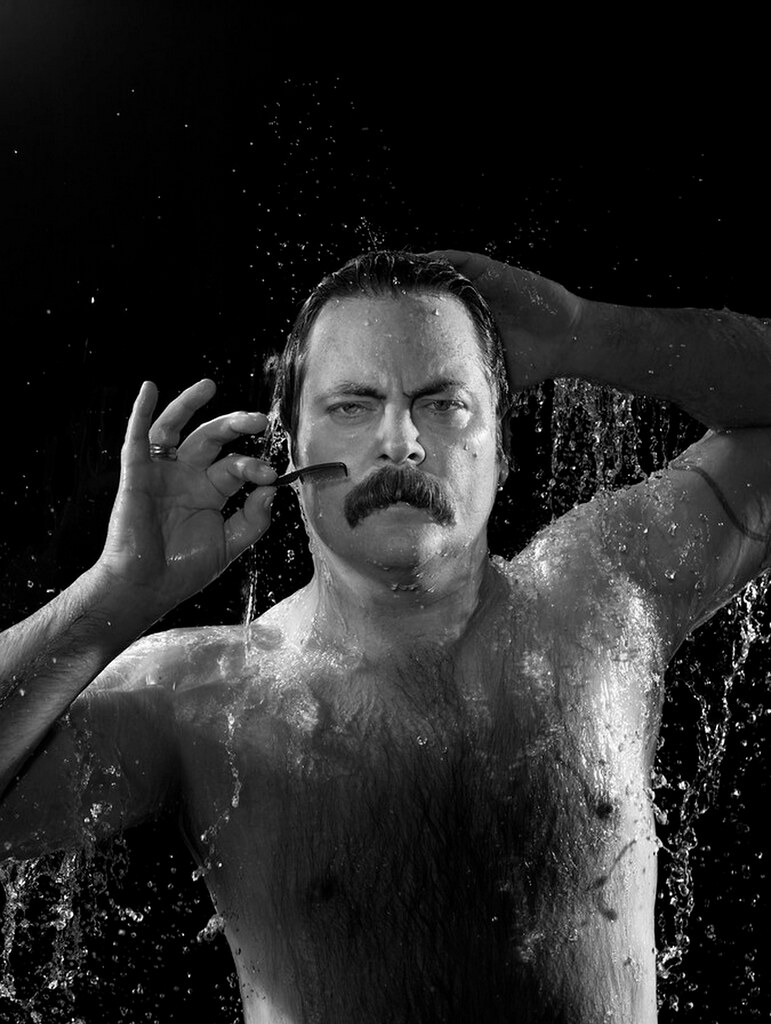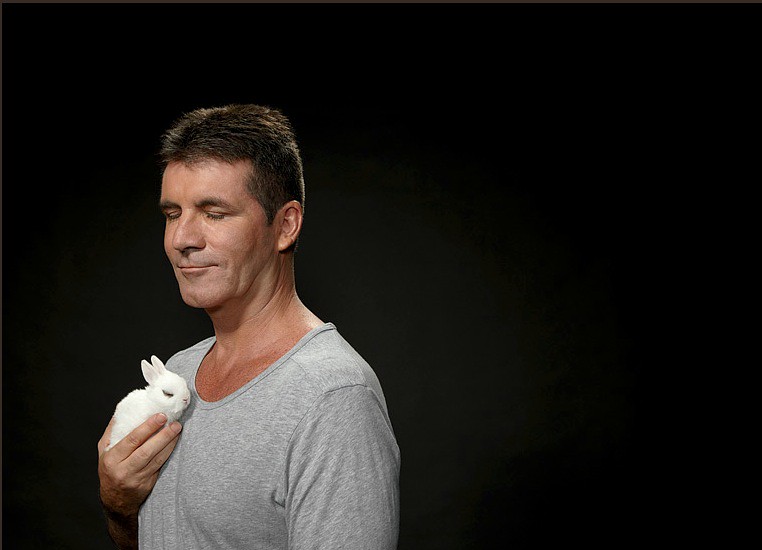You’ve been shooting professionally, successfully, for a very long time now. What kind of shoots are you looking for to keep you excited? Do you need to seek those out?
There’s a number of ways I can answer the question. I guess the first thing that comes to mind is that I still feel like I have so much I need to do to make my work better. Frankly shooting with celebrities and politicians and such, they’re such challenging contexts in which to work, to try to make a portrait. Obviously there’s inherent things that make it easier, like if you’re photographing someone who has a recognizable face, there’s all their history and just the fact that they’re recognizable…you could show a portrait sitting with the President and it could be a pretty uninteresting picture and people would say, “Wow! You photographed the President!” Doesn’t really matter what the picture looks like.
I think that my picture is better than that. Obviously I’m super biased but I do think my picture is a little unique. There is that. I’ve always tried to do pictures of celebrities where the only value wasn’t that it’s someone we recognize. Obviously there’s some value, but it’s not the only value. And occasionally people will say things about my work that reflect that, they’ll say, “oh, this would be interesting even if it wasn’t so & so.” Or, “this is art, not just a celebrity picture,” and obviously I’m very happy to hear that. But that’s what I strive for, to make pictures of celebrities that are at least a little surprising or take you somewhere that most celebrity pictures don’t take you. That remains a challenge every time, and I’d say it’s really rare that I make a picture where I’m like, “that’s it, I nailed it.” At least immediately. Later on, with a little time…my agent jokes with me saying, “you don’t like your work for at least six months,” and it’s true!
Now she’s learned to not say, “hey I like what you just did can we put it on the website?” She waits a while, and then she comes to me. Recently I took pictures of Mac DeMarco, a young musician. Wearing a suit, black & white, a spit bubble just dripping. The magazine ordered that and I thought, that is certainly the best picture I’ve done in a while, this is like a home run, it hits all the marks: it’s beautiful, it’s surprising, it’s disgusting, and it also reflects him and it reflects me, it’s all the things you want out of a portrait, at least for me.
And other people seem to feel that way, other people give me feedback that suggested it as well, and I was so pleased magazine ordered it. There were other pictures I liked from that shoot as well. It was a great shoot. But that doesn’t happen that often, where I feel that strongly. Even pictures of mine that have become iconic aren’t usually the ones that are my favorite from the shoot. At some point you just have to live with it. One thing that’s happening lately, in the last couple years is, I’ve been getting jobs that are challenging for me in terms of subject matter or context. For example I’ve done a couple things were I’ve done pictures where the subject is also the client. I did pictures of Tegan and Sara recently. I was hired by them because they needed new PR pictures. I had met Sara a couple times, really liked her a lot, and I was a fan of their music, so I was really excited about it.
But I’ve always found that context to be really crippling in the past, because you see from my work that I’ve been around for a while, but my work is pretty aggressive in the way I tried to get what I want, I coax it from people, I manipulate it from them, I kind of…people say stuff like, “I don’t take photographs I make photographs.” I feel like I take photographs. I take them from you, the subject. I’ll take them whether you want to give them or not. I think that it’s definitely something, at least my kind of portraiture, where you have to have that attitude. Maybe it’s because I’m Canadian and I’m nice, and I don’t really like not to be nice, but I have to go in with an almost assassin’s approach, “I am getting the shot!” So working alongside people like Tegan and Sara, or I did some artwork for a TV show starring Kim Cattrall. And again, working with her and the other stars of the show was a very different thing for me, but I was very open to it and it worked out well in both cases. I think that because I have such experience, I felt confident in some of the areas that were going to be involved with the shoot, going into a scary area was something that I felt more comfortable with than I would have been ten years ago.
A friend of mine is a photographer, and she’s a big fan of yours as well, and she wanted me to ask you if you still get scared about work stuff?
Like going in to do a shoot?
Mm hm.
Yes, I do get scared, I get very nervous, but I plan a lot, and the planning is as much to make me feel okay about going in as it is about actually being prepared. Obviously being prepared is very important too, but it’s a huge psychological thing, if you got a list of ideas ranging from if this person is ready to do anything, like Mac DeMarco, or here is someone who will do almost nothing, like the President, that I can get something I’m happy with. And obviously the expectations of them are different too. If I got the President to do a spitball that would be history-making!
Hahahaha, right! When you went in with the President, because I know you have a big list of ideas, did you go in with any ideas?
Sure! Initially when we were planning with the magazine, The New Republic, we had a bunch of ideas, and…the White House sort of nixed most of them. What actually happened, initially the interview was going to be something to do with youth and technology and things like that. But about a week before the shoot the White House talked to the magazine and said the President’s agenda is going to be more about such and such, because it was just before his second inauguration. So it was going to cover the state of the union, and what his plans were for the next year, so it became more general. I had this idea of having him texting, “what if we had him with ear buds in?” You wouldn’t see the device. Obviously he must exercise and wear ear buds, it’s not like it’s out of the realm of possibility. But just to see the President wearing something so iconic, so associated with…you see people on the subway with them…
More pedestrian?
More youthful. You don’t see a lot of old people doing that, it’s a more youthful picture, very contemporary-feeling. But they said no to all that. You know, I always kind of go in with the ideas of, “what if they’ll do nothing? What if they’ll do anything?” With the President, they told us that we would have between three to five minutes. Somehow seemed like anything wasn’t a possibility, and if anything it’d be, he does something and it’s interesting and we get it.
Do you hear that, “three to five minutes,” and just… (sigh)
No. Oh god, no. With politicians you know it’s going to be like that, I’ve done some great shots in my career where I’ve had five to seven minutes, and I think what’s great about those shoots is, there’s an energy with everyone, there’s no gently moving in, you’re out of the gate and you’re going for it. And the great thing with photographing the President was, he’s not chatty.
People are like, “oh, is he nice?” And I say, “no, he was business-like.” And I knew he was like that because I’ve read enough about him, and I follow politics, I knew he was a little bit of a a cold personality in person. So I wasn’t surprised, I wasn’t expecting anything else. And frankly, if it was Bill Clinton, we would have shot half as many frames because he talks so much. So I was actually really happy. And he was actually more cooperative than I expected. Because he asked what kind of expression did I want. Which I didn’t expect because a lot of politicians will come in and they’ll smile the whole time, and that’s really uninteresting. But he asked if I wanted him smiling or serious, and I said “serious.” So right out of the gate it was positive. In the sense of being cooperative and everything.
You mentioned in the beginning that there’s a lot of stuff you still want to work on. What kind of things do you feel you’re deficient in?
I guess…I wish my pictures were more visually interesting. I mean it’s an ongoing conflict in that I often like pictures, of other people’s work, that do something interesting that’s really simple, but in terms of lighting and context, there will be something going on, it’ll be kind of odd and somewhat disturbing, but it will be subtle. And it won’t be dramatic or literal. And yet…I feel my work could be more clever or just more, I don‘t know, taking it further. I’m not a technically-minded person, and I‘m certainly more technical now than I was when I was starting out. But I wish I could more easily pull that stuff out and deliver. Make the pictures more visually dynamic.
Hm, because I’ve always considered your work visually arresting.
Thank you.
It seems anchored in the idea that you have for each photo, but then it’s all brought out very visually.
I feel like sometimes I‘m successful with that, and other times less so. I don’t know. It’s hard to define, in a way it’d be easier to just show you other people’s work that have that.
That have something that you feel is lacking in your own work?
Yeah. I’ve been thinking in the last few days that I’d like to do more celebrity portraits that are kind of a lesser version of Presence (Buck’s photo series where celebrities are hidden, completely, within a scene), with less going on. And more where they’re turned away, or half-hidden, sort of integrated into a scene in a way that doesn’t scream “here is a celebrity portrait.” But they’re still really interesting pictures. Because I often find when I try to do pictures that are too subtle, they end up just looking like nothing happened. I don’t know if you’ve ever had that, like when you’re shooting and you think, “this is really a moment. It’s quite subtle, but there’s really a connection.” Then you look at the actual pictures, and whatever connection was there, and obviously I know it was real because I felt it, that’s not coming through in the picture. I know for me that’s not my strength, so that’s why I often try to get in something that’s a little bit conceptual, or some kind of little twist or prop or something, I find that brings it out.
Keep reading the complete interview on The Photographic Journal.
And check out Chris Buck’s amazing work here.







